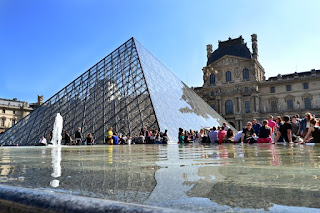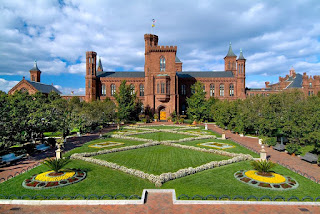 |
Your Daily English Programme #27 - Smithsonian Institution & Louvre Museum (Reading B1-C1) |
Welcome back to Engramme: Your Daily English Programme. Today's post has a special focus on science and on history. Let's find out!
 |
Think Before You Read |
Look at these 2 Photos: Do you know which two places they are and where each is located? Have you been to them before? What is each famous for? (type your answers in the comments below)
 |  |
 |
Time to Read |
Read the Descriptions Below: Which of the two places is older? Which one is dedicated specifically to the advancement of science?
Mouse over the underlined words to see their meaning
(1)
Heir to the century of the Enlightenment and the French Revolution, the Louvre (left-hand side picture above) was immediately accepted as the "museum of museums", and since then it has remained a model and a recognized authority.
Formerly a royal palace, the Louvre has embraced the history of France for eight centuries. Intended as a universal museum since its inception (August 10, 1793), its collections - among the finest in the world - span several thousands of years and a territory that extends from America to Asia. Divided among eight departments, these collections feature works admired throughout the globe, including the Mona Lisa, the Winged Victory of Samothrace, and the Venus de Milo. With nearly ten million visitors in 2012, the Louvre is the world’s most visited museum1.
The Smithsonian Institution (right-hand side picture above) is a group of museums and research centers administered by the Government of the United States, mostly located in the Greater D.C. Area, with additional facilities in other states. Home to 19 museums and galleries, nine research centers, as well as the National Zoo, the Institution is one of the world's foremost research centers in science, the arts, and the humanities.
The Institution aims to shape the future by preserving the human heritage, discovering new knowledge, and sharing research with the world. As a steward and ambassador of cultural connections, the Smithsonian also helps to build bridges of mutual respect and understanding of the diversity of American and world cultures.
The Smithsonian Institution was founded on August 10, 1846, with funds from the Englishman James Smithson (1765-1829) according to his wishes "under the name of the Smithsonian Institution, an establishment for the increase and diffusion of knowledge."2
 |
Let's Practice |
Here's a Summary of the two passages above: Fill in the blanks with words from the passages:
Mouse over the blanks to see hints
Ever since its __________ in 1793, the Louvre Museum has become a model
and an authority for many other museums. Its collections _______ several millennia
of human history and _________ as far as the Americas and Asia. The
collections exhibit works of art that are _________ all around the world.
The Smithsonian Institution was established in 1846, with initial _______
from the British scientist James Smithson. Under the name of the Smithsonian Institution, the establishment became a center “for the increase
and _________ of knowledge among men”, in accordance with Smithson’s will.
The Institution’s major goal is to _________ the human heritage and share new
discoveries and research with the world. It also aims at advancing ________ trust
and respect among various world cultures.
|
(see answers in the first comment below)
 |
Over to You |
Which world-known national institutions and/or museums exist in your country? What are they famous for? Do they host any public programs/activities to inform people about the arts, science, history, etc? (share your ideas in the comments below)
Thank You for following our posts on Engramme. We hope that our lessons help you improve your English on a daily basis. Click the buttons below to share this post with your friends.
Would You Like to Practice the Vocabulary from this lesson? Click here.
You're a Teacher intending to use this content in your classroom? Click here for a print-friendly copy.
1 Text courtesy of the Louvre Museum website, reproduced here with minor changes↩
2 Text courtesy of Smithsonian Institution Homepage, reproduced with minor changes↩
Answers to the ‘summary’ exercise:
ReplyDeleteInception – span – extend – admired – funds – diffusion – preserve – mutual